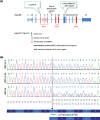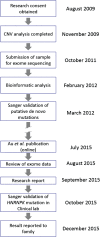A de novo frameshift in HNRNPK causing a Kabuki-like syndrome with nodular heterotopia
- PMID: 26954065
- PMCID: PMC5006848
- DOI: 10.1111/cge.12773
A de novo frameshift in HNRNPK causing a Kabuki-like syndrome with nodular heterotopia
Abstract
Kabuki syndrome is a heterogeneous condition characterized by distinctive facial features, intellectual disability, growth retardation, skeletal abnormalities and a range of organ malformations. Although at least two major causative genes have been identified, these do not explain all cases. Here we describe a patient with a complex Kabuki-like syndrome that included nodular heterotopia, in whom testing for several single-gene disorders had proved negative. Exome sequencing uncovered a de novo c.931_932insTT variant in HNRNPK (heterogeneous nuclear ribonucleoprotein K). Although this variant was identified in March 2012, its clinical relevance could only be confirmed following the August 2015 publication of two cases with HNRNPK mutations and an overlapping phenotype that included intellectual disability, distinctive facial dysmorphism and skeletal/connective tissue abnormalities. Whilst we had attempted (unsuccessfully) to identify additional cases through existing collaborators, the two published cases were 'matched' using GeneMatcher, a web-based tool for connecting researchers and clinicians working on identical genes. Our report therefore exemplifies the importance of such online tools in clinical genetics research and the benefits of periodically reviewing cases with variants of unproven significance. Our study also suggests that loss of function variants in HNRNPK should be considered as a molecular basis for patients with Kabuki-like syndrome.
Keywords: HNRNPK; Kabuki; exome; heterotopia.
© 2016 The Authors. Clinical Genetics published by John Wiley & Sons A/S. Published by John Wiley & Sons Ltd.
Figures



References
Publication types
MeSH terms
Substances
Supplementary concepts
Grants and funding
LinkOut - more resources
Full Text Sources
Other Literature Sources
Medical
Miscellaneous

